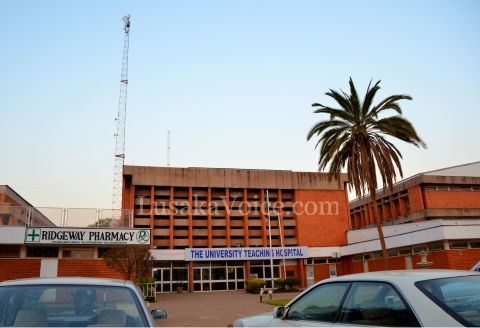IN 1934, the UTH started with only 15 beds and one white doctor but over the past 50 years, it has evolved from an institution with inferior infrastructure and equipment to modernisation.
THE University Teaching Hospital (UTH), formerly Lusaka Hospital, was constructed in 1910 as a random collection of rondavels (a westernised version of the African-style hut) situated where the railway line now crosses the Great East Road (near the fly-over bridge).
At the time, it was a 15-bed capacity hospital meant only for sick Africans who were cared for by male orderlies.
In 1914, the newly formed Lusaka Township Management Board (LTMB) resolved to station a medical officer in Lusaka.
Therefore, in 1915, a Dr Ward was transferred from Ndola to become Lusaka’s first white doctor to care for Africans at this hospital.
Thereafter, in 1918, the first European Hospital was built near the existing African hospital, which consisted of two huts, originally built as accommodation for Dr Ward and only housed eight beds.
However, the doctor moved into a brick house and in the same year, Dr Ward was joined by two nurses to assist in running the European hospital.
Both these hospitals, however, did not have operating theatres and all surgical cases had to be sent to either Broken Hill (Kabwe) or to Livingstone.
In 1921, a bigger single storey European hospital was built east of the railway line. It had a large bed space with eight wards, an operating theatre, and a nurse duty room.
The front ward and entrance were connected to a veranda that ran along the sides and back of the hospital.
However, the hospital did not have electricity or proper sanitation.
The annual report for 1921 states that this hospital became too small and minor cases had to be admitted to the old European hospital near the African rondavels.
Surgical operations for both blacks and whites were done in the new European hospital and this necessitated transportation of African patients from one section to another.
By 1926 there was congestion in the African section as the average daily number of patients was 20 for a hospital that officially accommodated only 15 at a given time.
In the early 1930s, plans for a new and bigger hospital were conceived but because of shortage of money, the plans were shelved until 1934 when the new hospital was started at present day UTH site.
The medical headquarters was then moved from Livingstone to Lusaka in 1935, and Medical Stores occupied the old European hospital premises.
This new hospital, which was largely for the Africans, had six wards of 30 beds each, two for male surgical cases, two male wards, one female and another for children.
There was also a maternity section with two beds but these were seldom occupied as African women distrusted western medicine.
These wards had no heating facilities or electricity apart from an open fire place half way down the corridor.
There was only a sink with a cold water tap at one end of each of the six wards.
The main kitchen lay in between the two rows of wards and had wood heated huts in which meals were prepared.
Meal times were erratic. Breakfast was at 07:00hours comprising cocoa and bread, supper at 18:00hours comprising nshima and kapenta or beans.
In 1935, the present day paediatrics (A/Block) was added as a hospital for Europeans with two wards one for males and the other for both women and children. There was a small maternity room at the end (now AO4).
Outpatient departments were opened two hours only in the morning from 08:00hours to 10:00hours and for one hour only in the afternoons from 14:00hours to 15:00hours.
In 1939, a bigger maternity wing was built for the European Hospital (now A02), accommodating 10 patients with room for more on the veranda.
The same year, Lusaka hospital became a training school for medical assistants (now known as clinical officers) and boarding accommodation was added in what is now former UTH club security.
In 1940, two temporary extra wards were built to accommodate soldiers sent down from the war in the Middle East.
And in 1967, the UTH was built and in 1969, the current maternity wing (B/Block) was opened.
A medical section was added in 1971 to boost the capacity in view of Lusaka’s ever increasing population seeking specialised medical treatment.
The casualty admission ward was opened in 1978, to be followed shortly by specialist clinics, surgical theatres and the new administration block.
On August 24, 1979, first Republican President Dr Kenneth Kaunda officially opened the current UTH.
UTH managing director Dr Lackson Kansonka said much has been achieved in the last 50 years of the institution’s existence.
Dr Kasonka said the hospital continued to expand with the Japanese government building D block Neonatal ward in 1983, Virology lab in 1992 and A Block Admission ward in 1997, which also houses offices for doctors and senior nurses.
He also said in 2007 the Adult Centre of Excellence was opened while another for children is still being constructed at the Paediatrics.
“There has been rapid growth and expansion since 1964. From 120 beds at independence to 1, 836 beds now. From four wards to 51 wards,” he said.
According to Dr Kasonka, the institution has grown from general to a specialist hospital adding that the institution has managed to achieve specialised services.
“Each general discipline has been broken down into specialist units,” he added.
He said UTH can boast of state-of-the-art diagnostic equipment while 20 years back, it relied on inaccurate x-rays.
Dr Kasonka said UTH has also invested in other advanced equipment like CT Scans, Magnetic Resonance Imaging (MRI) and a Cardiac Catheterisation laboratory among others.
He said in 2007, the hospital, in collaboration with Ministry of Health (MoH), embarked on an ambitious journey to build and upgrade existing infrastructure to international standards.
The works which commenced earlier this year, have focused on resurfacing the road network to bituminous standards.
Works on the Adult Filter clinic, now to be called Adult Medical Emergency Unit (AMEU), are in progress and when completed, it will be a three-storey ultra-modern facility with over 100 bed spaces, more than double the number of the old filter clinic ,which had 40 bed spaces.
Zambia Daily Mail

 JOIN DRIVERN TAXI AS PARTNER DRIVER TODAY!
JOIN DRIVERN TAXI AS PARTNER DRIVER TODAY!












So give us medicine not always india